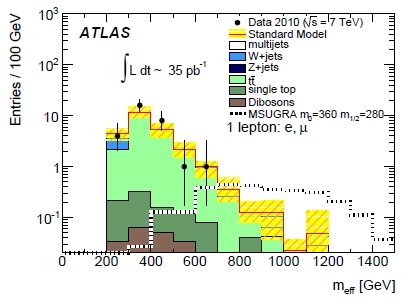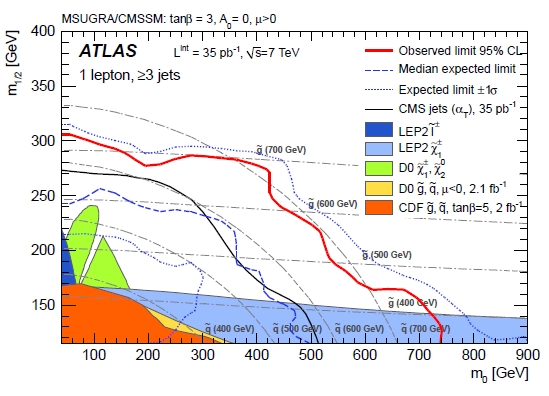Once you've watched the video, you can spend the rest of your coffee break reading the interesting piece by Kathy. Of course I love to sponsor it here, since she quotes me extensively, and with me two Italian colleagues (one of which I happened to co-tutor in his Ph.D. thesis, a couple of geological eras back).
About the news: if you have not heard about it yet, an ATLAS paper appeared a week ago to discuss the search for signatures including muons and jets, while a CMS paper, appeared over a month ago, considered instead the missing Et plus jets signature. Curiously, the two searches ended up having an almost identical sensitivity to the SUSY parameter space (actually, with a slight edge by CMS), and yet this time ATLAS was more "lucky", seeing fewer events in their signal box than predicted by background expectations, while CMS got the worse of it, seing more events than they expected. The result ? ATLAS excludes a significantly wider chunk of parameter space.
 The ATLAS result is based on the search for events containing an energetic lepton (electron or muon), missing transverse energy, and three or more jets. This signature can be produced by a variety of supersymmetric decay chains, as well as by several standard model processes -most notably, top production (in light and dark green) and diboson production (in brown), as shown by the figure on the right. In it you can see the effective mass of the system of reconstructed bodies, which shows that the data (black points) are well reproduced by expected backgrounds (red line with uncertainty in hatched yellow), which is dominated in fact by ttbar production. A particular point of the SUSY parameter space would produce an excess of events, shown by the dashed black histogram.
The ATLAS result is based on the search for events containing an energetic lepton (electron or muon), missing transverse energy, and three or more jets. This signature can be produced by a variety of supersymmetric decay chains, as well as by several standard model processes -most notably, top production (in light and dark green) and diboson production (in brown), as shown by the figure on the right. In it you can see the effective mass of the system of reconstructed bodies, which shows that the data (black points) are well reproduced by expected backgrounds (red line with uncertainty in hatched yellow), which is dominated in fact by ttbar production. A particular point of the SUSY parameter space would produce an excess of events, shown by the dashed black histogram.The agreement of data and standard model predictions is used to extract limits on Supersymmetry. In the figure below you see the exclusion by the ATLAS search as a full red line. The two axes show two relevant parameters of the SUSY space: these are the "universal" mass values of SUSY sparticles of spin 1/2 and 0. ATLAS sweeps away the previous limits by Tevatron and LEP experiments. The limit ATLAS expected to set based on the analyzed dataset and analysis technique is shown with hatched line: as you see the difference is sizable. And this was only driven by observing a couple of events less than expected! This tells you that the search is statistics-limited, and that this year a further big jump in sensitivity is to be expected.

CMS, whose result is also shown as a black curve in the plot above, studied events just featuring missing transverse energy and jets. This is known to be a priori the best search channel for "inclusive" Supersymmetric signatures at hadron colliders: not requiring a lepton increases backgrounds, but accepts the most signal. The reason for the large acceptance to signal events is that squarks and gluinos are coloured objects, and thus can be copiously pair-produced in the interaction of two regular hadrons. The chain of decays of pairs of such particles ends up producing jets and, if R-parity is conserved, a couple of neutralinos -particles that escape undetected and produce an imbalance in the transverse energy detected by the experiment. (I should mention that the ATLAS search is also sensitive to squarks and gluinos, but only when a chargino is produced in the decay chain, yielding an additional charged lepton. In this sense, the ATLAS search is more "exclusive", but that does not mean it should be more sensitive).
In the figure you may check that the black curve (CMS exclusion) closely follows the expected exclusion of the ATLAS search... And CMS saw more events than predicted, so their observed result (black curve) is worse (excludes less) than they expected. The ATLAS figure does not show the CMS expected limit, unfortunately... (Wink).
And what do theorists say ? A lot of things, as is also clarified by the Physics World article. However, I should mention here a very quick reaction in print, by our friend Ben Allanach, a theorist specialized in Supersymmetry. (Ben has been a guest in my blog a couple of years ago, with an insightful article on predictions for SUSY particle masses).
A fresh off the press paper in the arxiv by Allanach uses the SUSY limits set by CMS to constrain the full space of parameters with a global fit to particle physics and astrophysics observables. I have no time to discuss the paper here, unfortunately, but Ben is always welcome to produce a new guest post on the matter! Curiously, Ben's article appeared in the arxiv on the same day that the ATLAS result also made its apparition. I am sure that Ben is presently using the ATLAS input for a further update of his fits right now!
Let me finish this article by mentioning that in Kathy's article, I am quoted at the very end to say the following:
"We will get in a crisis, I think, in a few years".
What I mean is that although SUSY might be there and still be unreachable even by the LHC at full speed, if we see nothing in three years or so there will be a rush to abandon the sinking ship... The next few years are going to be quite interesting!!




Comments